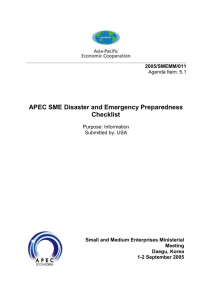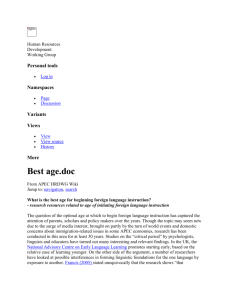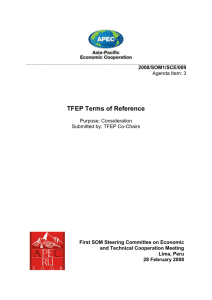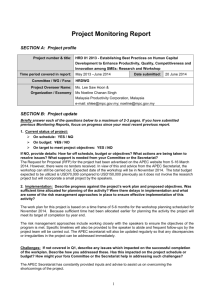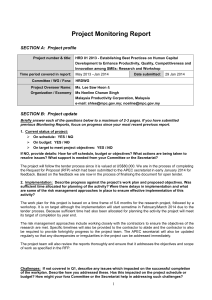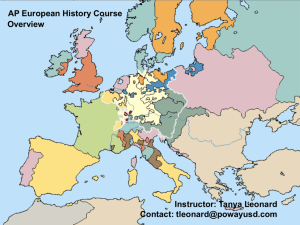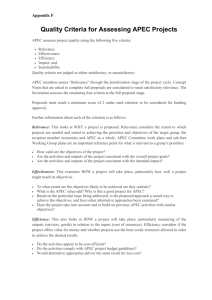Workshop on Global Supply Chain Resilience
advertisement
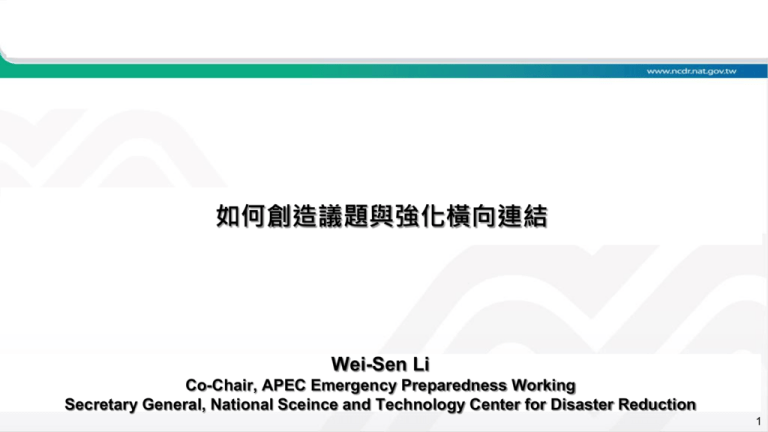
如何創造議題與強化橫向連結 Wei-Sen Li Co-Chair, APEC Emergency Preparedness Working Secretary General, National Sceince and Technology Center for Disaster Reduction 1 The Challenges for SME’s • Internationalization has been expensive for SME’s. – Capacity – cant afford to hire international staff – High barriers to entry in market development • SME’s using only basic technology. – Not generally directly connected to large customers – Capacity - Do not have experienced IT staff • Communications – Capacity- do not have multilingual business or technical staff • Need to prove to suppliers they can perform. – Sound logistics partners – Plan B Michael Mudd Importance of SMEs in the APEC regions over 97% of enterprises in APEC are SMEs • 99-100% – 13 of 21 APEC member economies www.apec.org 3 Importance of SMEs in the APEC regions economic contributions by SMEs • China – 59% of GDP, 2011 • Korea – 54% of GDP, 2010 • Canada – 39% of GDP, 2008 www.apec.org 4 Top priorities of APEC Emergency Preparedness Working Group since 2010 • • • • Business and community resilience Public-private partnerships Disaster risk reduction Cooperation and coordination with regional and international stakeholders • Preparations for the recovery phase 5 First Step: “APEC Workshop on Private Sector Emergency Preparedness” held in Sendai 2011 • The first international workshop after the Great North Eastern Japan Earthquake and Tsunami • The purpose of workshop is to enhance capacity in the Asia-Pacific to protect business, trade and economic growth, as well as communities, from disruption caused by disasters. • This workshop focus on strengthening public-private partnership capacity for emergency preparedness and Business Continuity Plan. 6 APEC Theme 2013 - 2015 Resilient Asia-Pacific : Engine of Global Growth Shaping the Future through Asia-Pacific Partnership Building Inclusive Economies, Building a Better World • Building Sustainable and Resilient Communities 7 APEC cross-fora efforts on improving business resilience • 2012 – Train-the-trainer workshop (SMEWG) – Developing Governments’ Capacity to Promote and Facilitate the Effective Use of Business Continuity Planning for Disaster Resiliency (EPWG, Australia) • 2013 – – – – – – APEC Seminar on Capacity Building for Disaster Recovery and Rehabilitation (EPWG) Policy Dialogue on Emergency Response Travel Facilitation (ERTF) (EPWG, BMG, SCCP) Business Continuity Planning: Policies, Practices and Programs (EPWG, Australia) Peer Group Review of BCP booklet/project effectiveness (EPWG, Australia) Workshop on Global Supply Chain Resilience (TPTWG, EPWG) Train-the-trainer workshop (SMEWG) 8 APEC cross-fora efforts on improving business resilience • 2014 – Seminar on Enhancing Regional Supply Chain Resilience to Disasters in APEC (EPWG) – Improving the Resilience of the Global Supply Chain (TPTWG, EPWG) – High Level Policy Dialogue on Resilient SMEs for Better Global Supply Chains (SMEWG, EPWG) – Train-the-trainer workshop (SMEWG) – The 6th Asia Ministerial Conference on Disaster Risk Reduction (UNISDR) – Secure Infrastructure Workshop on Critical Infrastructure Security and Resilience (CTWG, EPWG) • 2015 – APEC Policy Dialogue for SME BCP Forum and Workshop (SMEWG, EPWG) 9 Project Milestones 2012/2 Project proposal approved 2012/4~10 Joint study in collaboration with EPWG and other stakeholders 2012 Preparation and Research 2012/7/11~12 Focal Point Network Meeting and Expert Meeting 16 Economies, 21 Experts and 300+ Participants 2013/3 nd 2 Focal Point Network Meeting and Expert Meeting 2013 Collaboration with ADRC Published: Guidebook on SME Business Continuity Planning 2013 Train the Trainer 2014/3/24 High Level Policy Dialogue on Resilient SMEs for Better Global Supply Chains 2014 Dissemination 2013/8 APEC Train-theTrainer Workshop on Promoting SME BCPs 16 Economies, 20 Experts, 44 Seed Trainers and 400+ Participants 10 Recommendations on Resilient SMEs to enhance business’s role at DRR (SMEWG, EPWG) in 2014 • Establish SME Business Continuity Plans to Facilitate Trade and Investment – Develop exclusive BCPs for all other industries to build up the capacity on disaster resilience for SMEs. • Implement BCP Guidebook for Better Global Supply Chains – Disseminating Guidebook in different languages – Organizing the local training programs to train the seed trainers – Sharing the best practices, knowledge and information • Enhance the Public-Private Partnership and Cross-Fora Cooperation – Collaborating within APEC and other organizations for promoting BCPs at SMEs – Integrating the resources from the public and private sectors and experts to strengthen the capacity of SMEs 11 Looking at disaster-resilient business through the global supply chain - trans-boundary and end-to-end issues Raw materials End customers www.apec.org 12 Boeing - A Global Supply Chain example © Boeing Aircraft Co. Seven Principles for enhancing global supply chain resilience (TPTWG, EPWG) 1. 2. 3. 4. 5. 6. 7. Share information and knowledge Promote disaster risk management and hazard mapping Support planning and business continuity Promote best practice policy, regulations, and flexibility Leverage regional cooperation to support the supply chain, Promote critical infrastructure protection Recognize and promote best practice in human resource and capacity management 14 Further comprehensive collaboration on business resilience through regional synergy Global Supply Chain Resilience Emergency Response Travel Facilitation TPTWG EPWG, SCCP, BMG SMEWG Business resilience CTWG EPWG Application of Open data and Big data to Emergency Preparedness Critical Infrastructure Security and Resilience APEC Contributions UNISDR Hyogo Framework for Action 2 (2015) Private sector’s involvement Conclusions • “Global” is the new local in view of global supply chain – efficient, fast, resilient and tailored-made value chain for the expanding APEC market • Orchestrating a turnaround in policy and practices – to accommodate dynamic changes of disaster risk management at business • Taking advantages of cloud computing – to enhance business resilience. • Incentivizing MSMEs to follow BCM and adaptable strategies – to improve safer, resilient and smart investment environment. • Standardizing BCP with strategy difference – to accommodate diversities among MSMEs. • Sharing and applying big data plus value-added information – to foster exclusive growth in the APEC region. 16 Thank for your attention BCP, an umbrella for the rainy days centretechnologies.com Wei-Sen Li E-mail: li.weisen@ncdr.nat.gov.tw 17
